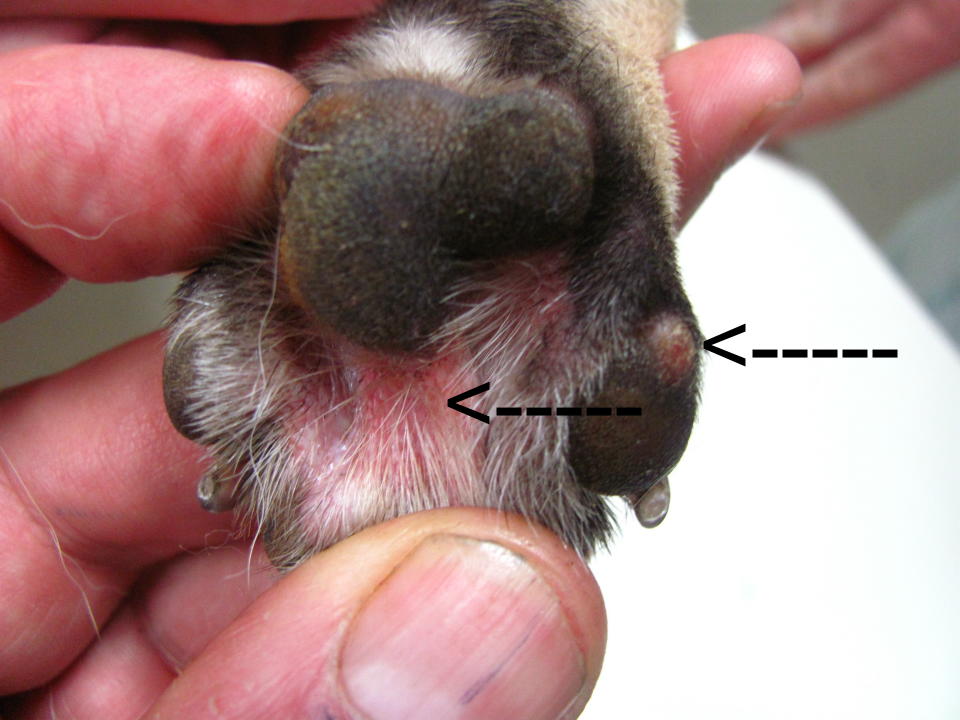Redness Between Dog Toes: Causes & Treatments for Itchy Paws
Does your dog constantly lick and chew at their paws? Do you notice redness, swelling, or irritation between their toes? Redness between dog toes is a common issue that can be caused by a variety of factors, from allergies to infections. While it might seem like a minor annoyance, it's important to address this problem to prevent discomfort and potential complications for your canine companion.
Imagine your dog frolicking in the park, only to come home and start obsessively licking their paws. This behavior can be the first sign of redness between the toes, and it's often accompanied by other symptoms like swelling, odor, and even limping. Ignoring these signs can lead to more serious issues like secondary infections and chronic skin conditions.
Understanding the potential causes of redness between dog toes is crucial for effective treatment. Allergies, often triggered by environmental factors like pollen, mold, or dust mites, can cause inflammation and irritation. Parasites like fleas, ticks, and mites can also lead to intense itching and redness. In some cases, bacterial or yeast infections might develop in the moist environment between the toes, further exacerbating the problem.
If you notice redness between your dog's toes, it's essential to consult with your veterinarian to determine the underlying cause and receive an accurate diagnosis. The vet will likely examine your dog's paws, ask about their medical history, and may recommend further testing, such as skin scrapings or allergy testing, to pinpoint the culprit.
Treatment for redness between dog toes depends on the underlying cause. For allergies, your vet may recommend antihistamines, medicated shampoos, or even allergy shots to manage your dog's immune response. Parasite prevention medications are crucial for preventing infestations that can lead to itchy paws. Bacterial or yeast infections typically require topical or oral antibiotics or antifungal medications.
Possible Causes of Redness Between Dog Toes
| Cause | Description |
|---|---|
| Allergies | Environmental allergens like pollen, mold, and dust mites can trigger allergic reactions in dogs, leading to itchy, red paws. |
| Parasites | Fleas, ticks, and mites can cause intense itching and irritation, especially between the toes. |
| Infections | Bacteria and yeast thrive in moist environments, making the space between a dog's toes prone to infections. |
| Contact Dermatitis | Irritants like grass, cleaning products, or certain fabrics can cause an allergic reaction on contact. |
| Other Causes | Underlying medical conditions, dietary sensitivities, and even stress can contribute to paw problems. |
Common Questions and Answers About Redness Between Dog Toes
Q: When should I be concerned about my dog's red paws?
A: If the redness persists, worsens, or is accompanied by other symptoms like swelling, odor, discharge, limping, or excessive licking, consult your veterinarian promptly.
Q: Can I treat my dog's red paws at home?
A: While home remedies like oatmeal baths or apple cider vinegar soaks might provide temporary relief, it's crucial to consult your vet for proper diagnosis and treatment.
Q: How can I prevent redness between my dog's toes?
A: Regular paw hygiene, thorough drying after walks, and year-round parasite prevention are essential for maintaining paw health.
Q: Are certain breeds more prone to paw problems?
A: Yes, dogs with hairy feet or skin folds between their toes, such as Bulldogs and Poodles, are more susceptible to moisture trapping and subsequent infections.
Q: What should I do if my dog is constantly licking their paws?
A: Excessive licking can worsen irritation and delay healing. Consult your vet to address the underlying cause and discuss ways to discourage licking.
Q: Can diet affect my dog's paw health?
A: Yes, food allergies can manifest as skin problems, including paw irritation. Your vet might recommend an elimination diet to identify potential triggers.
Q: How long does it take for redness between dog toes to heal?
A: Healing time varies depending on the cause and severity. With prompt treatment, most cases improve within a week or two.
Q: Is it normal for my dog's paws to smell?
A: While a mild, yeasty odor can be normal, a strong, foul odor often indicates an infection and warrants veterinary attention.
Tips and Tricks for Maintaining Healthy Paws
- Regularly inspect your dog's paws for redness, swelling, or foreign objects.
- Keep the fur between their toes trimmed to prevent matting and moisture buildup.
- Wash your dog's paws after walks, especially in wet or muddy conditions.
- Consider using dog boots to protect their paws from harsh weather conditions, allergens, or rough terrain.
- Provide a balanced diet and fresh water to support overall skin and coat health.
Redness between dog toes is a common ailment that, while often manageable, shouldn't be ignored. By understanding the potential causes, recognizing the symptoms, and seeking timely veterinary care, you can help keep your furry friend's paws healthy and happy. Remember, a proactive approach to paw care can prevent discomfort and ensure your dog enjoys every walk and playtime adventure to the fullest.
Decoding the depths your garmin echomap uhd2 53cv guide
Disposable shower caps the convenient travel essential
Unlocking the enigmatic world of nyt mini crossword clues













